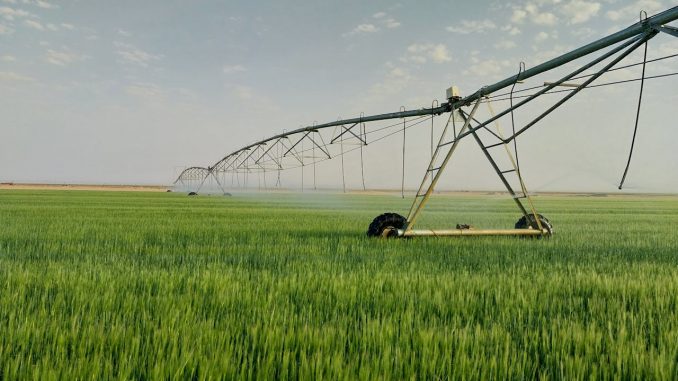
Pivot irrigation has become one of the most widely used methods of irrigating crops, particularly in large-scale agricultural operations. It is a mechanical system that rotates around a central pivot point, distributing water across fields in a circular pattern. Farmers often choose this system for its ability to cover large areas with minimal labor and its potential for water conservation. But just how efficient is pivot irrigation water? In this article, we’ll explore the factors that contribute to the efficiency of pivot irrigation and how it compares to other irrigation methods.
What is Pivot Irrigation?
Pivot irrigation, also known as center-pivot irrigation, consists of a long water pipe mounted on wheeled towers that slowly rotate around a central point. The system uses sprinklers to deliver water to the crops as it moves in a circular path. The radius of the system can vary, covering hundreds of acres in some cases. This method is particularly effective for crops like corn, wheat, and soybeans that are planted in large fields.
Pivot irrigation systems are generally automated and can be equipped with modern technology like soil moisture sensors and remote control systems to optimize water delivery. These features make pivot irrigation an attractive option for farmers looking to increase water use efficiency and crop yields.
Efficiency of Pivot Irrigation
The efficiency of pivot irrigation is measured in terms of water distribution uniformity and water conservation. The goal is to apply water evenly across the entire field, ensuring that crops receive the right amount without over-watering or wasting resources. Several factors contribute to the overall efficiency of pivot irrigation water:
1. Uniform Water Application
Pivot irrigation systems are designed to deliver water evenly over the field. Sprinklers are spaced along the length of the pivot arm to ensure consistent coverage, and nozzles can be adjusted based on the crop’s water needs and the soil type. This uniform distribution helps reduce water wastage compared to less precise methods like flood or furrow irrigation, where water may pool in certain areas and not reach others effectively.
2. Water Conservation
One of the most significant benefits of pivot irrigation is its water-saving potential. Modern pivot systems can achieve up to 90% efficiency in water use, meaning that nearly all the water delivered by the system is used by the crops. This high efficiency is achieved through low-pressure sprinkler systems and precision irrigation techniques, which reduce evaporation and runoff.
For instance, Low Energy Precision Application (LEPA) nozzles, used in some pivot systems, release water closer to the ground, minimizing the loss of water to evaporation. Additionally, sensors and smart controllers allow farmers to monitor soil moisture levels and adjust water applications in real-time, further reducing waste.
3. Reduced Labor and Energy Costs
Pivot irrigation is also more efficient in terms of labor and energy usage. Once installed, the system requires minimal manual intervention, as it can be automated to water fields according to a pre-set schedule. This reduces the labor costs associated with traditional irrigation methods like furrow or drip irrigation, which require more manual oversight.
The system also uses less energy than some high-pressure irrigation methods, as pivot systems can operate at lower pressures. This combination of reduced labor and energy use contributes to the overall efficiency and cost-effectiveness of pivot irrigation.
Factors Affecting Pivot Irrigation Efficiency
While pivot irrigation is generally very efficient, certain factors can impact its effectiveness. These include:
- Terrain: Pivot irrigation systems work best on flat terrain. In hilly areas, the system may not distribute water evenly, reducing its overall efficiency.
- Wind: Strong winds can disrupt the spray pattern of the sprinklers, leading to uneven water distribution and higher evaporation rates. Wind can reduce the efficiency of a pivot system by as much as 30%.
- Maintenance: Like any mechanical system, pivot irrigation requires regular maintenance to function at peak efficiency. Clogged nozzles, leaks, or mechanical failures can lead to water wastage and decreased system performance.
Comparing Pivot Irrigation to Other Methods
Compared to traditional irrigation methods like flood or furrow irrigation, pivot systems are generally much more efficient. Flood irrigation can lose up to 50% of the water to evaporation, runoff, or poor distribution, whereas pivot systems can deliver water with over 90% efficiency. Drip irrigation, another common method, is slightly more efficient than pivot systems in terms of water conservation, but it requires more maintenance and labor, making it less practical for large-scale operations.
Conclusion
In conclusion, pivot irrigation is an incredibly efficient method of watering crops, particularly when modern technologies like low-pressure nozzles and soil moisture sensors are used. With uniform water distribution, reduced labor and energy costs, and the ability to conserve water, pivot irrigation systems provide an effective solution for farmers looking to maximize productivity while minimizing water use. While certain factors like terrain and wind conditions can affect its efficiency, pivot irrigation remains one of the best options for large-scale agriculture in terms of water conservation and overall system efficiency.

Leave a Reply